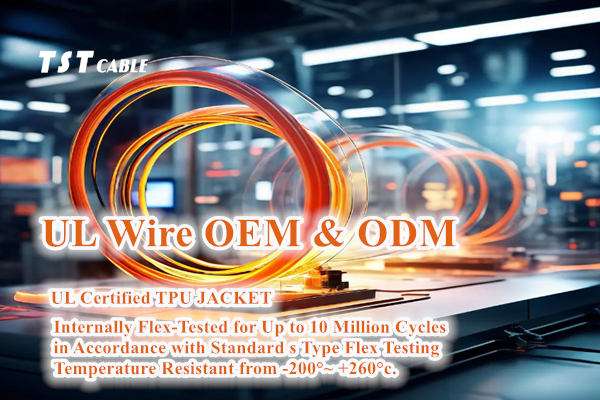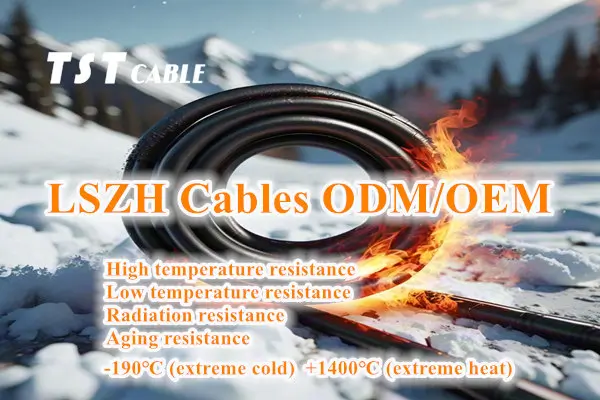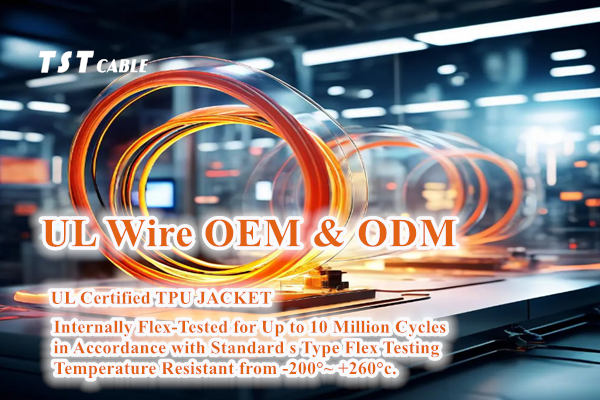Types of fireproof cables:

The most widely used fireproof cables at this stage are mainly UL series flame-retardant cables(UL1581) and flame-retardant low smoke halogen-free cables. Among the imported products, they mainly come from America and Europe. Since the fireproof cable standards in America and Europe are incompatible with each other, the fireproof ideas are very different. Therefore, Party A and the design institute are in a passive state when choosing products. Each has its own reasons, and in the end they often choose according to the actual situation of funds.
The UL flame retardant standards mainly have the following grades: CMP, CMR, CM, CMG, CMX.
1) Boosting Grade – CMP Grade (Plenum Flame Test/Steiner Tunnel Test)
This is the cable with the highest requirements in the UL fire protection standard (Plenum Cable). The applicable safety standard is UL910. The test stipulates that multiple specimens are laid on the horizontal air duct of the device and burned for 20 minutes with an 87.9KW gas Bunsen burner (300,000 BTU/Hr). The qualified standard is that the flame cannot extend beyond 5 feet from the front of the gas Bunsen burner flame. The maximum peak value of the optical density is 0.5, and the maximum average density value is 0.15.
This CMP cable is usually installed in the air return booster system used in ventilation ducts or air handling equipment, and is recognized and adopted by Canada and the United States. The FEP/PLENUM material that meets the UL910 standard has better flame retardant properties than the low-smoke halogen-free material that meets the IEC60332-1 and IEC60332-3 standards, and the smoke concentration is low when burning.
2) Riser Grade-CMR Grade (Riser Flame Test)
This is a commercial grade cable (Riser Cable) in the UL standard, and the applicable safety standard is UL1666. The experiment stipulates that multiple specimens are laid on a simulated vertical axis and burned with a specified 154.5KW gas Bunsen burner (527,500BTU/Hr) for 30 minutes. The qualified standard is that the flame cannot spread to the upper part of the 12-foot-high room. There is no smoke density specification for trunk-grade cables, which are generally used for vertical and horizontal wiring on floors.
3) Commercial Grade-CM Grade (Vertial Tray Flame Test)
This is a commercial grade cable (General Purpose Cable) in the UL standard, and the applicable safety standard is UL1581. The experiment stipulates that multiple specimens are laid on a vertical 8-foot-high bracket and burned with a specified 20KW ribbon blowtorch (70,000BTU/Hr) for 20 minutes. The qualified standard is that the flame cannot spread to the upper end of the cable and extinguishes itself. UL1581 is similar to IEC60332-3C, except that the number of cables to be laid is different. Commercial-grade cables do not have smoke density specifications and are generally only used for horizontal wiring on the same floor, not for vertical wiring on the floor.
4) General-purpose-CMG (Vertial Tray Flame Test)
This is a general-purpose cable in the UL standard, and the applicable safety standard is UL1581. The test conditions for commercial and general-purpose cables are similar, and both are approved for use in Canada and the United States. General-purpose cables do not have smoke density specifications and are generally only used for horizontal wiring on the same floor, not for vertical wiring on the floor.
5) Home-grade-CMX (Vertial Wire Flame Test)
This is a home-grade cable (Restricted Cable) in the UL standard, and the applicable safety standards are UL1581, VW-1. The experiment stipulates that the sample is kept vertical, and the test torch is burned (30,000 TU/Hr) for 15 seconds, then stopped for 15 seconds, and repeated 5 times. The qualified standards are that the residual flame cannot exceed 60 seconds, the sample cannot be burned by more than 25%, and the surgical cotton pad at the bottom cannot be ignited by falling objects. UL1581-VW-1 is similar to IEC60332-1, but the burning time is different. This level also has no smoke or toxicity specifications and is only used in home or small office systems where a single cable is laid. This type of cable should not be laid in bundles and must be sheathed.
Low smoke halogen-free cable (LSOH cable)
Low smoke halogen-free cable, as the name suggests, is a cable that produces less smoke and does not contain halogen when exposed to fire. The principle of low smoke halogen-free is to prevent the cable from producing a lot of toxic gas and smoke when burning in the flame, so that people will not cause great casualties in the burning, greatly improving people’s survival rate in fire.
Low smoke halogen-free fireproof cable UL1581 standard and application
UL 1581 is one of the standards issued by Underwriters Laboratories Inc. (UL), which specifically regulates the safety performance of wires, cables and flexible wires. This standard is widely recognized around the world, especially in North America, to ensure the safety and reliability of wire and cable products under various application conditions.
Below TST CABLES introduces the UL 1581 test standard in detail. Friends who are interested in low-smoke halogen-free cables and high-temperature cables can follow our official website to continuously update the leading technical trends and industry content of low-smoke halogen-free cables.
Scope of low-smoke halogen-free UL 1581 standards
UL 1581 mainly covers safety test standards for electrical wires, cables and flexible wires. These products are commonly used in building wiring, equipment connections, communication systems and other fields. The standard is designed to evaluate the electrical properties, mechanical properties, chemical resistance, heat resistance, combustion characteristics, etc. of these products.
Best end-use markets and applications for low-smoke halogen-free UL 1581 cables
Industry applications: consumer cables, automotive wiring harnesses, EV charging, industrial cables
Certifications and standards: REACH, RoHS and IMDS
Target applications: flame-retardant cable sheaths with drying temperature grades of 90°C and 105°C.
UL 1581 test items for low smoke and halogen-free
UL 1581 includes a number of test items, the most well-known of which is the combustion performance test for wires and cables. Specifically, it includes but is not limited to the following items:
1. VW-1 vertical combustion test: used to evaluate the combustion characteristics of a single insulated wire and cable.
2. FT1 and FT2 vertical tray flame tests: test the combustion reaction of wires and cables in a fixed position.
3. FT4 vertical combustion test: used to test cables with larger diameters.
4. FT6 horizontal combustion and smoke test: in addition to combustion performance, it also includes the evaluation of smoke generation.
In addition, there are tests such as bending performance, temperature resistance, tensile strength, low smoke and halogen-free.
The purpose of the low smoke and halogen-free UL 1581 test standard
The purpose of the low smoke and halogen-free UL 1581 standard is to ensure that wire and cable products will not cause safety hazards such as electrical failures or fires due to material problems during installation and use. Products that meet the UL 1581 standard can provide higher safety guarantees.
Low smoke zero halogen UL 1581 application scenarios
The low smoke zero halogen UL 1581 standard applies to various types of wires and cables, including but not limited to:
Household appliance connection wires
Fixed wiring inside buildings
Industrial equipment connection wires
Data communication cables
Requirements of Section 50 of Low Smoke Zero Halogen UL1581
Maintain 65% of tensile strength and 70% of ultimate elongation at 90°C rating – 121°C for 7 days. The minimum tensile strength and elongation of the unaged sample are 12.9 Mpa and 300% respectively.
Maintain 35% of tensile strength and 85% of ultimate elongation at 105°C rating – 136°C for 7 days. The minimum tensile strength and elongation of the unaged sample are 17.2 Mpa and 450% respectively.
UL 1581 Low Smoke and Halogen Free Certification Process
In order to obtain UL 1581 certification, manufacturers must submit their products to UL for a series of rigorous tests. After successful testing and passing the review, the product can be affixed with the UL mark, which not only enhances the market reputation of the product, but also provides safety assurance for consumers.
UL 1581 is a very important standard and is essential to ensure the safety of wire and cable products. Whether it is a manufacturer or a consumer, understanding and following the UL 1581 standard is a key step to ensure product quality and user safety. As technology develops, TST CABLES will also regularly update the standard to adapt to the challenges of UL’s new technologies and new materials.
Also available in:
English



